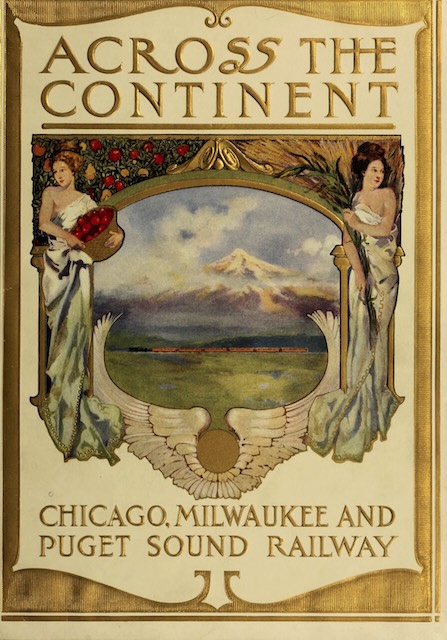In conjunction with the introduction of the Olympian and Columbian in 1911, the Chicago, Milwaukee and Puget Sound Railway issued this gorgeous booklet filled with both sepia-toned and beautifully hand-colored pictures of a trip on the new rail line. The booklet was written by Isabelle Carpenter Kendall, and therein lies a tale.
 Click image to download a 19.5-MB PDF of this 68-page booklet.
Click image to download a 19.5-MB PDF of this 68-page booklet.
When Isabelle Kendall was born in about 1864, women weren’t expected to work after they got married. Her father was the St. Paul Railway’s general passenger agent, and she aspired to a career with the railroad, but he didn’t want to hire her, perhaps because he figured she would quit when she got married. So instead she went to work as a stenographer in one of the railroad’s freight offices in 1884.
After three years in that job, with the encouragement of her parents, she left the railway to get a degree in journalism from the University of Illinois. In 1897, she returned to the railway, working directly for one of the vice presidents until 1903, when she married a St. Paul Railway conductor named George Kendall. Of course, that meant she had to retire from her railroad duties. However, her husband died less than five years later, so she went back to work for the railway in 1908.
At the time, the St Paul was building its Pacific Extension, so the company sent her out to “acquire local color” about the new route. Starting from Mobridge, South Dakota, where the St. Paul ended and the Puget Sound began, she traveled using a combination of the Northern Pacific, horseback, handcars, and on foot to see such places as Sixteen Mile Canyon, Pipestone Pass, and the Bitterroot Mountains. When the line was completed in 1909, she toured it again, this time by train and in the company of a photographer. These trips made it possible for her to write Across the Continent so it could be released in time to advertise the new Olympian and Columbian trains.
In 1913, the railway decided to begin publishing an employee’s magazine and asked Kendall to be its editor. Due to still lingering concerns about having a woman work for the railroad, the masthead ambiguously listed her as Carpenter Kendall. While everyone in the company headquarters knew and many other employees must have known Carpenter was a woman, the magazine didn’t reveal that fact in print until its 25th anniversary issue in 1938.
Initially, the magazine was titled The Milwaukee Railway System Employes Magazine, shortened to The Milwaukee Employes Magazine in 1919, simply The Milwaukee Magazine in 1923, and finally The Milwaukee Road Magazine in 1950. All of the issues of the magazine can be downloaded from a website called the Milwaukee Road Archives. Note the word “employes” instead of “employees,” which my spell checker objected to but which many dictionaries say is acceptable, if dated.
Also note that the magazine’s initial title used the term “Milwaukee Railway System” at a time most people — including Kendall in Across the Continent — called the company the “St. Paul Railway.” The railway was founded in Milwaukee, but when it reached St. Paul in the early 1860s, that the western frontier of the United States, so calling it the St. Paul Railway was a way of advertising the exotic destination that its trains could reach. It didn’t receive the nickname of Milwaukee Road until it emerged from bankruptcy in 1928, at which time the official name also used the term “railroad” instead of “railway.”
Kendall, who lived in a Sears Roebuck kit home in Libertyville, Illinois, continued to edit the magazine for more than 25 years. On the magazine’s 25th anniversary, the railroad gave her a diamond studded wristwatch. She finally retired in 1940 at the age of 76, living 4 more years before passing away in her home in Libertyville. She was remembered as being “intensely loyal” to the railroad and its employees.
We’ve seen this booklet before, but it contained various markings from the Library of Congress. I decided to remove those and post this cleaner copy so I could tell the story of Isabelle Carpenter Kendall.
